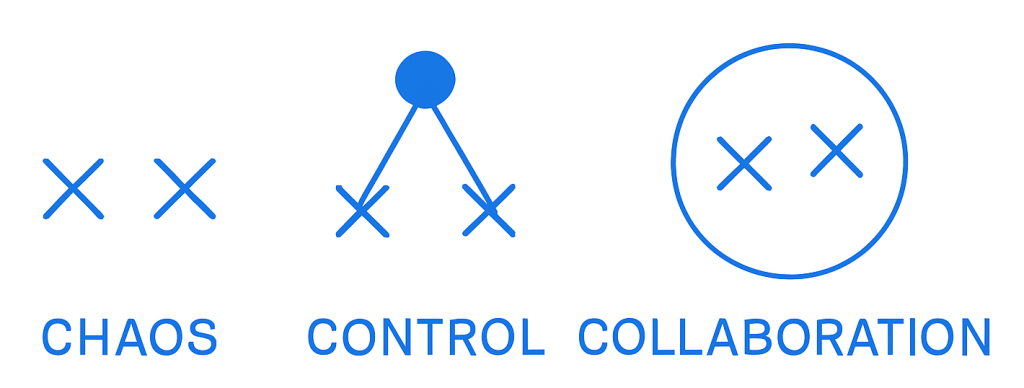In ORGANIZATIONS 101 I explored what makes an organization: interacting individuals with defined responsibilities and clear accountability. This post looks at what comes next—how those design choices shape very different organizational experiences.
Over the years, I’ve come to see that all organizations settle into one of three basic states: Chaos, Control, or Collaboration. Each state emerges from two fundamental, either-or, design distinctions: Is the organization unorganized or in fact organized? And is power distributed unequally or equally?
These are foundational design decisions—choices that shape how people work, how authority flows, and how outcomes are produced.
Unorganized vs Organized
The first distinction is about structure — the presence (or absence) of clear roles and accountability.
When unorganized, there is a lack of clarity. Roles may be undefined or constantly shifting. Accountability can be vague or absent altogether, leaving people unsure of their responsibilities or priorities. Lack of clarity creates chaos. That’s why organizations require structure. Without it, order disintegrates. Conversely, when organized, defined expectations create structure. People know what they’re responsible for and how their efforts connect to others. Control doesn’t necessarily mean rigidity — it just means clarity.
Why this matters? Structure enables coordination and progress.
Unequal vs Equal Power
The second distinction is about power — specifically, how decisions are made and responsibilities are completed, and how individuals are connected to each other.
In organizations with unequal power, some individuals wield authority over others. This hierarchical structure is based on the BUREAUCRATIC MODEL. It might be efficient, but it concentrates control — which research shows can dampen engagement and creativity. Conversely, there is no overarching power structure in organizations based on equal authority. Roles are clear and decision-making is distributed. Structure still exists but it is created and exercised collectively.
Why this matters? Authority shapes how people participate and how leadership is shared – or withheld.
When we combine these two design choices — structure and power — we arrive at three distinct organizational states: Chaos, Control and Collaboration.
Chaos (Unorganized)
Organizations in this state lack structure. Roles are undefined or constantly shifting. Accountability is unclear, and authority — if it exists at all — is inconsistently applied or poorly understood. In traditional work oriented organizations, people spend more time navigating ambiguity than completing tasks. There’s often a lot of action but very little progress. Energy could be high, but direction and cohesion are definitely low.
Summary: Low coordination. Unstable outcomes.
Control (Organized + Unequal Power)
Organizations tend to land here by default. It’s the organizational structure we’ve learned – unconsciously – to create order. Put someone in charge. Roles are then clearly defined, and decisions flow through a chain of command. Authority has been centralized — which provides stability, but often at the cost of initiative, engagement, and innovation. People know where they stand, but not always where they’re going — or why. Traditionally, predictability has been prioritized over participation. This is the bureaucratic model: structured, consistent, and again, often misinterpreted as the only viable option.
Summary: Stable. Predictable. Often disengaging.
Collaboration (Organized + Equal Authority)
This state is about working together — one that scales from teams to communities and beyond. Structure is still present — with clear roles, shared expectations, and mutual accountability. But power is not concentrated – there is no overriding authority. Instead, leadership is distributed and decisions are made collectively. The result is a sense of ownership, alignment, and adaptability. Again, collaboration isn’t the absence of structure — it’s structure without hierarchy.
Summary: Shared Power. Collective momentum.
